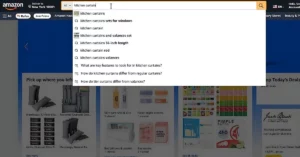
Amazon pushes returnless returns to save on logistics costs, but this policy shifts the financial burden to sellers, who lose the product and the revenue.
This cycle of returns and refunds has become a major headache for businesses, with the logistical costs often outweighing the value of the product itself.
In response, Amazon is increasingly pushing “returnless returns” on sellers, a strategy that helps the platform cut its own operational costs but shifts the financial and inventory burden directly onto you.
Amazon Pushes Returnless Returns, Updates Its Policy
Liz Morrell, Internet Retailing"The most successful retailers are those viewing returns not as a singular process but as an ecosystem requiring multiple solutions working in harmony."
Amazon has rolled out three new return policy settings that change how sellers manage inventory once it enters the FBA system. These updates affect how returns are processed, evaluated, and owned, with lasting effects on profitability.
This is what I discussed on one of our Amazon agency’s latest YouTube videos, where I explained why these settings matter and what sellers should do immediately. By default, one of these options is disabled while the other two are enabled, and each carries different risks and advantages.
The Three New FBA Return Settings
Sellers can now manage three distinct settings within their FBA account:
Returnless Resolutions
This setting gives sellers the option to let customers keep certain items without sending them back for a refund. It makes financial sense for low-cost products where the shipping and processing costs of a return would outweigh the value of the item.
Returned Item Evaluation
When enabled, this feature allows Amazon to determine whether a returned item is in a sellable condition. If you disable this setting, all returns are automatically marked as unfulfillable, and you lose any eligibility for damage reimbursement.
Damaged Inventory Ownership
This is the most controversial update. If Amazon damages your inventory, they will reimburse you for your sourcing cost, then retain ownership of the item and resell it through other channels. This change reduces a seller’s control and raises concerns about Amazon profiting from its own mistakes.
Why These Matter for Sellers
These settings shift risk and inventory control away from sellers. In practice:
- Resale opportunities are reduced.
- Amazon profits from inventory it damages.
- Reimbursement outcomes may favor Amazon more than sellers.
When Returnless Resolutions Make Sense
This setting can be helpful when the cost of processing a return outweighs the value of the item. It is particularly useful for:
- Low-cost items that are not profitable to resell.
- Products often returned in unsellable condition.
If your products regularly come back in good condition, keeping this option disabled helps protect revenue.
Returned Item Evaluation and Why It Matters
When this setting is enabled, Amazon decides if a returned item can be resold. If it is disabled, all returns are automatically classified as unsellable, and sellers lose the ability to claim reimbursement for damaged items.
Keeping this enabled is generally safer, as it preserves reimbursement eligibility and prevents unnecessary write-offs.
Damaged Inventory Ownership Is The Biggest Concern
The most controversial change involves inventory damaged by Amazon. When this happens, sellers are reimbursed at sourcing cost, but ownership of the damaged product stays with Amazon.
Amazon then resells the product through Amazon Warehouse or other outlets, reducing seller control and raising concerns about Amazon profiting from these errors. Historically, sellers could reclaim ownership, but that option is no longer standard.
Not Only Amazon, But Other Retail Giants Also Adopt Keep It Policies
According to El Diario 24, both Amazon and Walmart are reshaping how customers return products. Their new policies allow shoppers to receive refunds without sending the items back.
This shift highlights a growing trend in retail. What was once a straightforward process of exchanging goods at the store is being replaced by returnless refunds.
The main driver is convenience and cost savings. Online returns are expensive to process, often requiring extra postage, repackaging, and handling fees.
By allowing consumers to keep the product, companies reduce logistical costs and save time. For retailers, fewer steps in the return chain mean less operational waste.
How Amazon’s Policy Works
Amazon rolled out its version of this policy in August 2023 under the FBA Non-Return Solution program. It applies to non-hazardous items, lightweight products, and goods priced under $75.
Products excluded from this option include:
- Hazardous goods
- Heavy or bulky items
- Products priced above $75
Walmart quickly followed with a similar policy. Its returnless refunds apply under certain conditions but share the same goal, reducing the hassle of traditional returns.
Other Retailers Joining the Trend
Target, Overstock, and Chewy are also adopting returnless refunds. For many retailers, the cost of shipping back low-value items is higher than letting customers keep them.
This practice is also viewed as a way to build goodwill. By refunding without requiring the product back, retailers hope to maintain customer trust and loyalty.
Fraud Concerns and Consumer Pushback
Not all consumers and critics support this model. Some argue it creates opportunities for fraud, with shoppers abusing the system to receive products and refunds.
Amazon has responded by monitoring accounts that file excessive refund claims. Accounts flagged for suspicious activity may see requests denied as a safeguard against abuse.
The Psychology Behind Returnless Returns
Roger Dooley wrote in his Forbes article that new research from the University of Notre Dame shows why returnless returns work so effectively. The study, published in the Journal of Marketing Research, found that this practice can significantly increase customer loyalty, word-of-mouth, and repeat purchases.
In 2023, a survey of major retailers revealed that 59% had adopted some form of returnless returns. That figure more than doubled compared to the previous year, signaling how quickly the approach is spreading.
The Reciprocity Principle at Work
The research demonstrates that customers perceive returnless returns as an unexpected favor. This activates the psychological principle of reciprocity, making them feel indebted to the brand.
In one experiment, students who received a replacement BIC pen without needing to return a defective one rated the brand more favorably than those who never encountered a problem. The study highlights how trust-building actions can outweigh the inconvenience of receiving a faulty product.
Why Trust Matters More Than Proof
One of the strongest findings involved the role of trust. When companies required proof of defects, most of the positive impact of returnless returns disappeared.
Conversely, when businesses refunded customers without demanding evidence, loyalty and advocacy rose sharply. The act of trusting the customer itself became the driver of stronger brand support.
How Companies Can Maximize Impact
The Notre Dame study also identified strategies that influence how customers perceive returnless returns:
- Customers responded more positively when returns felt like special treatment rather than a blanket policy.
- Explaining that the policy saves customers time or supports sustainability was far more effective than citing cost reduction.
- Encouraging customers to donate unwanted items boosted perceptions of brand warmth and responsibility.
A Seller’s Action Plan To Protect Margins
Given these policy changes, sellers must be proactive to protect their profits. By taking immediate action, you can regain control over your inventory and make sure you’re not leaving money on the table.
First, analyze your return data. Use the FBA Returns report in Seller Central to identify which ASINs have the highest return rates and the most common reasons for return. This will help you understand if a product’s high return rate is due to a customer-perceived defect, incorrect sizing, or a different issue that can be addressed in your product listing.
Second, review your FBA return settings. You have the power to customize how these new policies apply to your business. Rather than accepting the default settings, you can tailor them to your specific products.
For Returnless Resolutions
Only enable this setting for products where the cost of a return (shipping, handling, and potential damage) is more than the item’s value. This is a smart choice for low-priced items or products that are frequently returned in an unsellable state.
For Returned Item Evaluation
It’s generally best to keep this setting enabled. If you disable it, all returns are automatically marked as unsellable, and you lose the chance for reimbursement. This option is critical for preserving your eligibility for damage claims.
For Damaged Inventory Ownership
This is a crucial setting to review. While keeping it enabled allows Amazon to reimburse you for damaged goods, that reimbursement is based on your sourcing cost, not the retail price. For high-value or branded items, it may be more profitable to disable this setting and retain ownership of the damaged product so you can dispose of it or attempt to salvage it yourself.
Kaleb Davis, GlobalEDGE from Michigan State University"Despite its convenience, the returnless refund method is not without drawbacks. It can lead to increased instances of return fraud and can encourage waste if customers choose to dispose of items instead of reusing or donating them."






